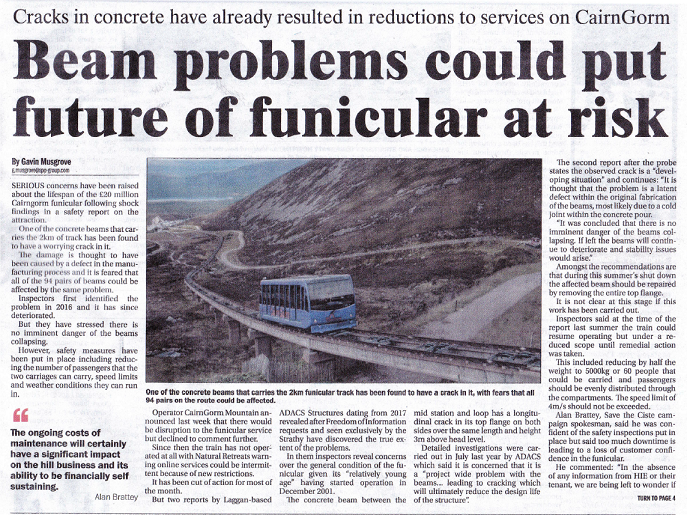
Alan Brattey here explains the background to the current crisis at Cairngorm and his comments as reported in the Strathy.
The CairnGorm Mountain Funicular Railway was constructed as a replacement for the ageing Carpark and White Lady Chairlifts, at a cost of £19.54m in public funding and EU funding. Add non-construction costs to that and Audit Scotland estimated (see here) that by the time of their report in 2009 over £23m of public funding had been invested in the funicular of which £19.4m of which came from Highlands and Islands Enterprise. The funicular came into service in 2001 and was forecast to eventually carry 200,000 skiers and 165,000 non-skiing passengers every year.

In the first 5 year of operation the non-skiing passenger numbers were good at: 180,000. 182,000. 177,226. 164,046 and 171,404. which is an average of 174,935. In the 5 year period up to 2015 the non-skiing numbers were: 117,313. 127,813. 129,311. 119,585 and 127,092 which is an average of 124,222. It’s evident therefore that the funicular is now carrying over 50,000 non-skiing passengers fewer than it did in the first few years of its operation. That reduction of almost 30% in passenger numbers has come at a time when the Strathspey tourist business has been booming. It is a well known fact that tourists do not make repeat visits to CairnGorm Mountain, year after year, because there is nothing there to attract them to visit again and it’s likely that tourist passenger numbers will fall further. Notably, the construction grant funding that came from the EU led directly to the imposition of a closed system that prevents tourists from exiting the Ptarmigan building. That is something that has a direct and constraining impact on the potential for repeat visits by summer tourists who cannot get out to walk on the mountain.
By contrast, snowsports customers will make repeat visits within each year and return year after year if they are provided with a good product and service.
The Funicular Railway has been beset by operational inefficiencies due to design flaws. During the summer, the uphill passengers are disembarked at the Ptarmigan station, at a point which has not enabled the downhill carriage to enter the Daylodge station. The downhill passengers have to wait until the uphill passengers have disembarked before their carriage can fully enter the station and they can get off. During winter operations the inefficiencies can be much more significant.
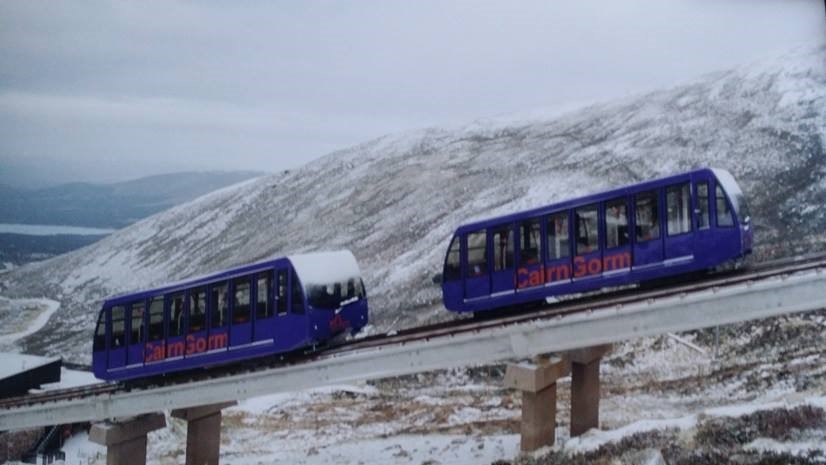
When passengers are embarking and disembarking at the mid-station then the Funicular has to make 2 stops because the uphill and downhill carriages are not simultaneously at the mid-station. That is something that occurs when there is no snow below mid station and snowsports customers cannot get up to the middle using surface ski lifts which are rendered inoperable due to the absence of snow. Similarly, those skiing/boarding downhill have to board the train at mid-station to get down to the Cas carpark. It’s an inexplicable design flaw that very considerably reduces the Funicular carrying capacity leading to customer dissatisfaction because of the resultant queues when there are no other mechanized means of getting up the hill.
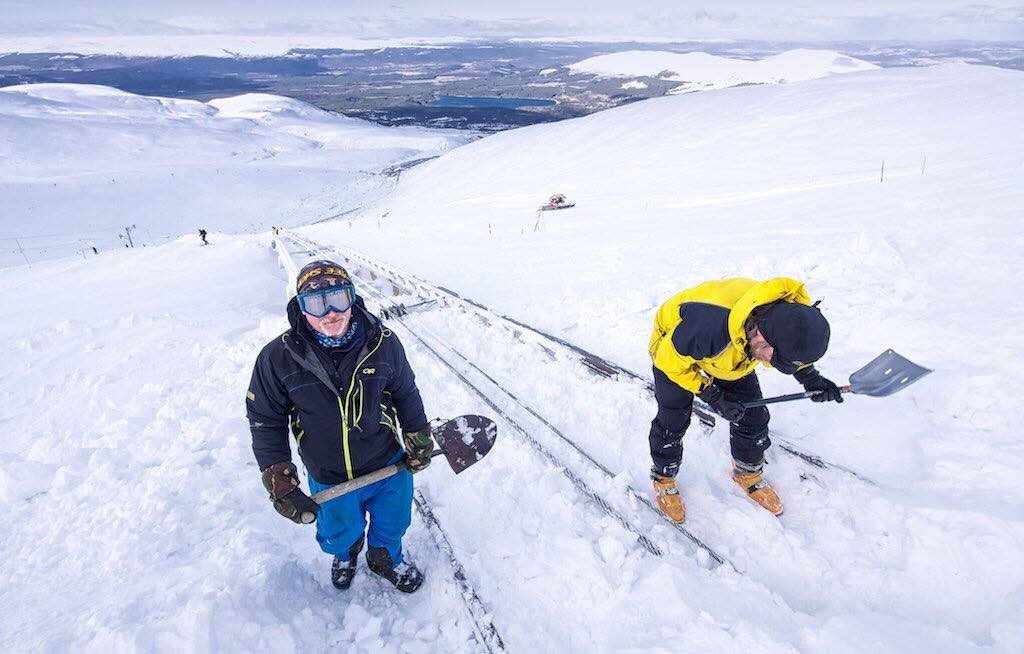
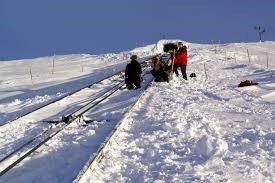
Additionally, the Funicular Track can become snowed in when drifts build up and cover the track as has happened on many occasions, most notably in 2010, 2014 & 2018.
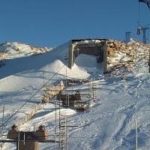 There are also days during most seasons when the Funicular tunnel mouth has been drifted in and up to 7m of snow has to be cleared, by hand. This has been a problem since the funicular was being constructed (see left). The labour costs involved since the Funicular went into service can only be guessed at but it’s an operational inefficiency that leads to late opening and customer dissatisfaction as well as unproductive costs.
There are also days during most seasons when the Funicular tunnel mouth has been drifted in and up to 7m of snow has to be cleared, by hand. This has been a problem since the funicular was being constructed (see left). The labour costs involved since the Funicular went into service can only be guessed at but it’s an operational inefficiency that leads to late opening and customer dissatisfaction as well as unproductive costs.
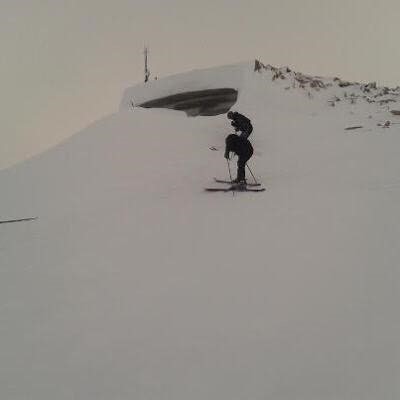
Since the Funicular was commissioned in 2001 the other snowsports uplift infrastructure has been significantly reduced. The core lift policy led to the closure and ultimately the removal of the Fiacaill T-Bar, the White Lady T-Bar, the Aonach Poma and the Coire na Ciste & West Wall Chairlifts. This strategy reduced uplift capacity by over 40% and the collapsing snowsports market share indicates that it was a monumental failure. Notably, only Cairngorm of the 5 Scottish snowsports areas employed this strategy and only CairnGorm is failing. Catering capacity has also been reduced with the loss of the Sheiling & Coire na Ciste base station cafes.
It is notable that the Funicular represents the only uplift on the mountain by which customers can reach the Ptarmigan building during the summer and the only way up to that level in winter if there is no snow below mid station. Even when there is good snow lie, only the M1 Poma reaches the Ptarmigan from the Coire Cas side of the hill.
The long-term strategy that has focused on the Funicular to the detriment of other uplift has left the mountain business extremely vulnerable whenever the Funicular is inoperable. This situation has been highlighted during 2018 when it was closed throughout the month of May. Recent FOI requests have revealed that a consultant’s’ report [Funicular Railway Beam Report; 17 July 2017] had identified that a concrete beam was cracked and had to be replaced:
1.2 During the annual inspection of the Funicular Railway concrete components one beam was noted to have a longitudinal crack in its top flange” (from Introduction)
6.3 During the summer 2018 shutdown, beam 51/R should be repaired by removing the entire top flange which will necessitate the removal of all the rail supports & re-cast using a suitable product (from recommendations).
As a consequence of this a number of things happened:
- scaffolding was erected to support the beam and another FOI has revealed this has so far cost HIE £4,255
- the Funicular had to be operated at no more than summer speed over last winter, and
- the consultants recommended that carriage capacity should be reduced to 60 from the design level of 120.
The maximum speed is 10m/sec but the reduced parameters required that it did not exceed 4m/sec…effectively reducing the uplift carrying capacity by more than half. If you add in the carriage capacity reduction from 120 to 60 then it can be seen that the Funicular was a very inefficient means of uplift, last winter.
Recently the Funicular has once again been operating within reduced parameters as publicized by the operator, Natural Retreats:
‘’Following on from observations made during our annual Funicular Inspection, engineers who specialize in structures like ours have been brought in to carry out further inspection, analysis and investigation. To allow this scope of works to progress we have been instructed to restrict the parameters of our normal operating procedures. These restrictions involve us monitoring the weather, windspeed and carriage capacity & are likely, at times, to restrict the opening of the Funicular over the next few weeks’’
In fact, during the week commencing Saturday 15 September the Funicular was closed on most days. The business interruption and consequential loss of revenue will be notable and the consequences for staff and customer satisfaction already apparent:
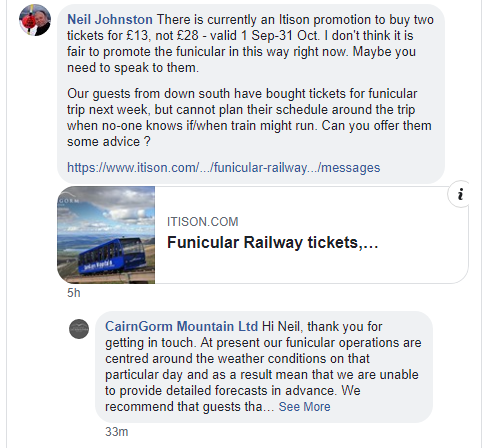
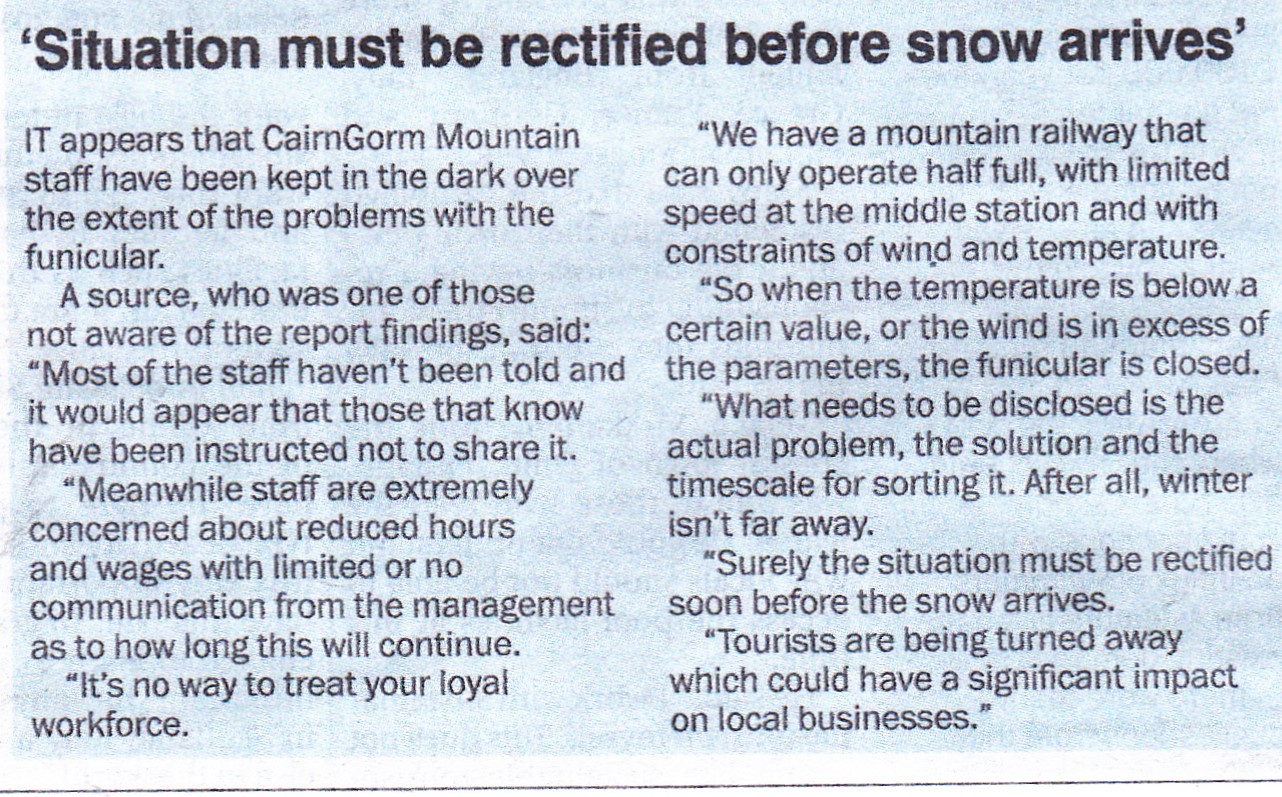
There is real concern now about the future reliable operability of the Funicular railway:
The Executive summary from the consultants’ report had this to say:
- In broad terms, the writer was concerned by the general condition of the Funicular Railway, given its relatively young age.
- There are numerous items of a maintenance nature that should be undertaken, it is likely that this will be required on an annual and ongoing basis.
- There are a number of more substantial repairs. This should not be a recurrent problem.
- There is concern that there is a project wide problem with the beams manifesting itself to a greater or lesser extent at different positions along the track. The problem manifests itself as excessive deflections, leading to cracking which will ultimately reduce the design life of the structure. At this stage it is not known if this is a design or a construction related problem and further detailed investigations would be required to identify the source of the problem.
Customer confidence in the Funicular is being eroded by the frequency of closures and HIE would be well advised to make what they are doing about its condition publicly known. It’s very clear that the maintenance costs, into the future, are likely to be significantly in excess of original forecasts.
The current problems would appear to be a direct consequence of HIE’s flawed decision to commission the funicular. First HIE accepted a consultant’s evaluation of the options to upgrade uplift at Cairngorm which made the funicular look far better than the other options of chairlifts or gondolas:
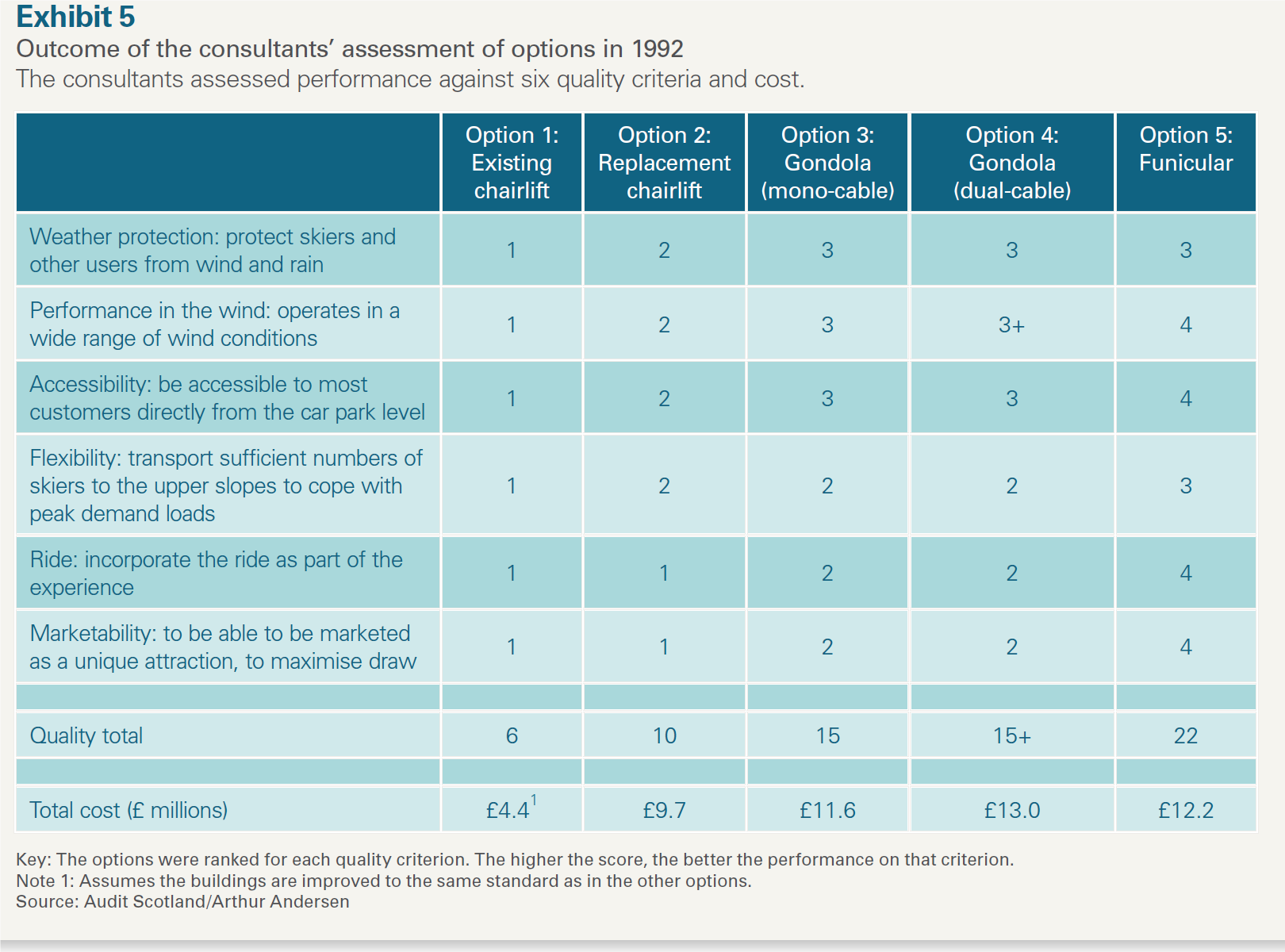
Then, in Audit Scotland’s words: ,
HIE agreed to changes to the project specification to reduce costs and stay within the budget of
£14.6 million (Appendix 1). The combined bid from Morrisons offered overall savings of £1.4 million against its original cost. Morrisons reduced the cost of the civil engineering work by £500,000 by, for example, changing the tunnel design and excavation method. They identified further general savings of £300,000 and savings of £545,000 from the design of the bottom and top stations. Some elements, such as installing a goods lift in the bottom station and removing the existing chairlifts, were excluded from the tender, giving a saving of £100,000. Other elements were respecified, for example, Morrisons proposed using less expensive finishes internally and externally.
Questions now need to be answered about whether the current problems with the funicular stem from those attempts to reduce costs.
The folly of HIE’s long term strategy at Cairngorm is now being fully exposed. If the Funicular cannot operate continuously and efficiently over the winter months, then there is insufficient uplift capacity to encourage snowsports customers to come to CairnGorm. The unnecessary destruction of the Coire na Ciste and West Wall Chairlifts led directly to customers abandoning CairnGorm in favour of other areas. In fact, the 4 lowest ever shares of the Scottish Snowsports market have come in the last 5 seasons with 2017/18, following the destruction of the chairlifts, being the worst ever, at less than 25% of the market. Snowsports customers have forsaken CairnGorm because they do not find the product/service to be acceptable and HIE’s claims that the weather was responsible for the market share collapse in the 2017/18 season are risible. With the business now fully reliant on the Funicular there is nothing the operator can do when the train cannot operate.
HIE appears to have been hoping that the construction of a new Ptarmigan building will reverse the drop in visitor numbers which in turn might bring in sufficient people to pay for the maintenance of the funicular. The current problems at the funicular show that strategy won’t work. HIE’s proposed £4m loan to Natural Retreats to pay for the new Ptarmigan will need to be paid off first before any additional money becomes available for essential maintenance. The maintenance cannot wait. In addition the Ptarmigan Plan relies on projections of future summer visitor numbers which past history shows are unlikely to materialise while doing nothing to address the fundamental issue in terms of visitor numbers and income, which is how should CairnGorm Mountain cater for snowsports.
The ineptitude of HIE management of the Cairngorm Estate and the assets thereon, made worse by the appointment of Natural Retreats who it was claimed would bring new investment to the mountain, is now beyond critical. Government intervention is required to sort out this ongoing shambles, re-think what infrastructure is appropriate at Cairngorm and how it should be best managed and funded.

Sorry guys. Having skied on Cairngorm from late 70s I could see this coming for the last 10 years. The management team have a lot to answer for as do other stakeholders. With the reduction in uplift this has led to less public coming back, the skiing will never be as it was in the 80s at peak times so sad. Proper planning and a 10 development plan are need as us new investors and stakeholders. We don’t need little companies opening up to make a quick buck we need long term investment and people who have a busyness background. People like Chris Tiso. Stephen Newlands. Andrew Michie Let’s get this mess fixed out because when it’s gone it’s gone.
I’ll not be going back to Cairngorm for a long time due to what the “management” have done to the area. Shameful and such a loss of what could be an awesome facility.
Yeah shareholders will give a great big flying #$×÷ the same goes for the people planning 10 development plans get back to earth please the mountains belong to the people not w##k bag corporate scum and investors .there should be no need for corporate scum to provide sports for our chidren the government is paid enough.
Gotta wonder at use of language, a valid point, but lost in abusive language which makes you look like a XXXX, and is ignored by those it’s directed at.
White elephant. I protested against the construction of this fundamentally flawed piece of infrastructure. As with so many of these projects the projected number of visitor numbers was hyped up. Time for a full enquiry to examine all aspects of the resort in the hope that a sustainable and environmentally sensitive solution can be found to secure the future of the resort.
Yes, HIE’s ineptitude seems never ending. We do need Scottish Government intervention – and fast – but let’s not pretend that they have the management ability to sort out this mess! I’m sure that with more digging they will be found to have backed HIEe’s mistakes all the way over the years.
It’s a major catastrophe of incompetence that we are facing. There is no easy answer but the start must incude:
– a complete disclosure by HIE and the Scottish Government of their failings
– the cancellation of the Natural Retreats contract
– a temporary operation plan to keep going what can be kept going – safely
– a fully funded extensive consultation with all interested parties
– employment of competent consultants to evaluate options including the option of scrapping of the whole funicular railway. The problem here is who can have confidence in HIE or the Scottish Government to select a competent consultant?
– more public consultation………and a promise of the selected option being fully funded by the Scottish Government.
If activities on Cairngorm Mountain are to be saved, a totally different management structure has to be in place, with HIE taking back seat. The Community Trust buy out is currently the only workable management option.
Hi Gordon
You make the point in the most concise coherent articulate way possible. Will it be heeded by the powers that be? One cat but hope!
I wholeheartedly concur with what you have written, and so eloquently.
Additionally Natural Retreats, their current Directors, should IMHO be banished from the mountain ASAP. The rights and wrongs (considerable as they are) should be glaringly obvious to any casually inquisitive observer and the notion of pumping a further £27 Million into this financial black hole is surely the line in the sand between “unfortunate management” and “wilful incompetence” close to misfeasance. The constant flow of public money (whether from HIE or government grant aka unrepaid loans) into a small handful of PRIVATE pockets is truly galling. Remember the recent examples of Carillion or BHS. Can we learn from these to prevent such financial mismanagement in the future? Are we, collectively, really too blind not to realise when a root and branch reappraisal at Cairn Gorm needs to be implemented. The physical detritus littering the old chairlifts at Cairn Gorm (please see the excellent article by Drennan Watson for graphic detail in http://parkswatchscotland.co.uk/2018/12/05/time-for-a-re-think-at-cairngorm/) is truly shameful and ideally should serve as a wake-up call to the HIE that current policy is failing, badly. As for the “surprising” structural defects in the Funicular’s foundations which came to light like a bolt of lightning as if from nowhere… Surely continual real-time monitoring should have revealed these axiomatic defective weak points from their infancy and further demonstrates that the current farce managed by clowns is far from exemplary and hasn’t been for quite a while.
In a wider context it makes Scotland a ready butt of jokes. The only mountain in Scotland with a railway up but guess what , it’s not working (even in December, when, arguably, it might be quite useful, especially to would-be skiers). Wow!!!
Suggested solution to the current problems on Cairn Gorm by HIE – let’s pump another £27 Million into it (presumably on the basis that the business model has worked SO well up to this point!!!!).
My answer – wake up, stop wasting public money, remove the current virus/cancer and start afresh with locals who actually know their stuff (as opposed to very well remunerated American Consultants who might or might not be able to pinpoint the UK on an atlas!!!).
The following suggestion is most likely quite whimsical, but for me if £27M IS going to be spent on Cairn Gorm development and infrastrucure then I’d feel a lot happier entrusting the project to the likes of Mr Povlsen than allowing HIE to come up with some wacky proposal from behind closed doors.
To use a rather glib football analogy the current state of play is like comparing Newcastle under Mike Ashley’s stewardship with that of Manchester City under that of Sheikh Mansour. On paper a British club under a British owner seems the “better” option, but in practice and actual fact some people might disagree. All I know is that what Mr Povlsen has done with his estate in Glen Affric is a demonstration of what can be achieved with the right focus and vision for the environment rather than on lining one’s own pocket. By all means use entrepreneurs, but choose which ones wisely and ethically.
Bankruptcies, companies falling into administration, powerful hedge fund managers ready to cream off profits, cronyism etc are anathema to Mr Povlsen. Wouldn’t it be nice if the same thing could be said with a straight face for all the current top bods of Natural Retreats, Natural Assets,, CairnGorm Mountain Ltd, the Great Travel Company, and the HIE executives. One does not need the investigatory skills of Robert Mueller to work out that a fair percentage of the price of a Funicular Ticket and how that money was squandered would not meet with universal approval from Joe Public. Some might call it value for money. Not me.
Let,s try and get the experts in to examine the concrete structures and come up with a plan of action to repair them and seek further funding for our funicular rail system .I take it the injection of a suitable epoxy resin into the cracks along with suitable strapping across crack would suffice in the short time to facilitate usage of the rail and a proper repair effected during spring/summer months. It is a fabulous facility to have and hopefully it can be saved as the access to the skiing it provides is second to none.